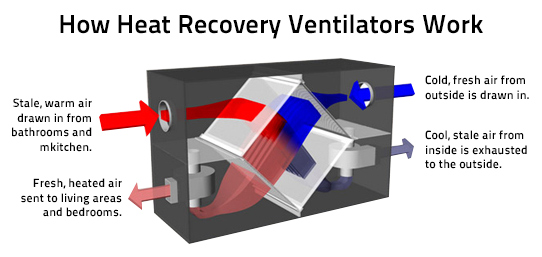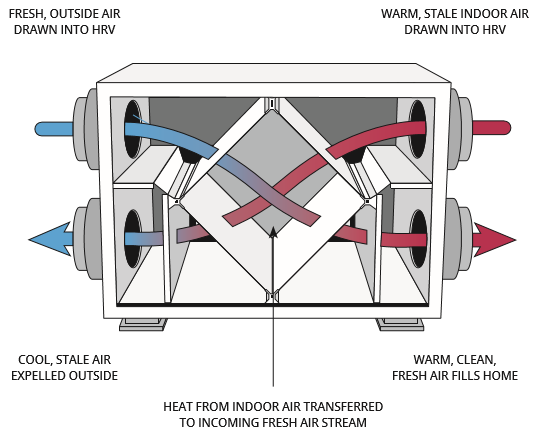Understanding HRV: A Complete Overview
Wiki Article
The All-Inclusive Guide to the Uses of Heat Recovery Ventilation in Modern Buildings
Heat Recovery Ventilation (HRV) systems represent a considerable development in building technology (HRV Heat Recovery Ventilation). They supply an approach for exchanging stagnant indoor air with fresh exterior air while decreasing power loss. This method not only boosts interior air high quality but additionally contributes to energy performance in both domestic and commercial buildings. Recognizing the numerous applications and benefits of HRV can reveal its crucial role in contemporary layout and sustainability efforts. The implications of this technology deserve exploring even moreUnderstanding Heat Recovery Ventilation Equipments

Although several modern buildings prioritize power performance, recognizing warmth recuperation air flow (HRV) systems is crucial for maximizing indoor air top quality and lowering power usage. HRV systems work by moving warm from stagnant indoor air to incoming fresh air, efficiently keeping comfy indoor temperatures while reducing energy loss. These systems are composed of a warm exchanger, followers, and ductwork that assist in the blood circulation of air. During wintertime, HRV units capture and recycle warmth from the outbound air, while in summer season, they can assist cool inbound air. By continuously exchanging air, HRV systems additionally lower moisture and the focus of indoor contaminants. Proper setup and upkeep of HRV systems are crucial for their effectiveness and effectiveness in enhancing total structure performance and comfort.
Benefits of Heat Recovery Ventilation
Heat recovery ventilation systems supply countless benefits that enhance both power performance and interior air top quality in modern-day structures. By capturing and reusing energy from exhaust air, these systems substantially decrease heating & cooling prices, causing lower power consumption. They keep a stable flow of fresh outside air, reducing the threat of indoor air toxins and allergens. This continual exchange assists manage humidity levels, avoiding mold and mildew growth and making certain a much healthier living environment. Furthermore, HRV systems add to sustainability goals by lowering overall carbon footprints. Their ability to maximize ventilation without giving up thermal comfort makes them a useful addition to modern building layout, promoting both economic and environmental benefits.Applications of HRV in Residential Structures
As property owners progressively focus on energy effectiveness and indoor air quality, the applications of warm recovery ventilation (HRV) systems in residential buildings have actually come to be extra common. HRV systems are specifically useful in snugly secured homes, where maintaining fresh air circulation is important for protecting against moisture buildup and indoor pollutants. They successfully transfer warm from outbound stagnant air to inbound fresh air, reducing power prices linked with heating and cooling. Additionally, HRVs can enhance convenience levels by managing moisture and temperature level. They are additionally adaptable for different property layouts, consisting of single-family homes and multi-unit buildings. Generally, incorporating HRV systems sustains lasting he said living methods while making sure a much healthier indoor environment for occupants.HRV in Commercial and Industrial Settings
In business and commercial settings, the implementation of heat recovery ventilation (HRV) systems has actually ended up being increasingly essential for optimizing power efficiency and preserving air quality. These systems effectively transfer warm from exhaust air to incoming fresh air, minimizing the requirement for added heating or air conditioning. This not check my reference only reduces power costs but likewise contributes to sustainability initiatives. Industries such as manufacturing, warehousing, and office buildings profit significantly from HRV systems, as they aid regulate temperature level and humidity degrees, ensuring a comfortable and productive setting. HRV systems help in getting rid of contaminants and excess moisture, improving interior air quality. As laws around air quality become stricter, the adoption of HRV technology is likely to grow, making it a vital element of modern commercial and industrial infrastructure.Future Patterns in Heat Recovery Ventilation Innovation

Often Asked Concerns
Just How Does Heat Recovery Ventilation Effect Indoor Air High Quality?
Heat recovery ventilation significantly enhances interior air top quality by continually trading stale indoor air with fresh exterior air while recouping power. This procedure reduces contaminants, keeps excellent moisture levels, and assures a healthier setting for residents.Can HRV Equipments Be Mounted in Existing Structures?
HRV systems can indeed be mounted in existing structures. Retrofitting may need modifications to web link ductwork and air flow layouts, but it substantially boosts power efficiency and interior air top quality, making it a feasible choice for older frameworks.What Upkeep Is Required for HRV Systems?

Are There Certain Climates Where HRV Is Much More Efficient?
Heat recovery ventilation systems are specifically reliable in climates with substantial temperature distinctions in between periods. These systems maximize energy effectiveness by recovering warm from exhaust air, making them excellent for both chilly and reasonably cozy atmospheres.Exactly How Do HRV Systems Affect Power Expenses?

Report this wiki page